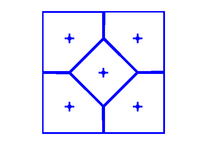Centroidal Voronoi tessellation

Okay sweetie, let's say you have a bunch of points on a piece of paper. You know how to make a circle around each point, right? Well, now let's think about connecting those circles together.
Imagine taking a crayon and drawing a line between two points, and then drawing lines in between all the other points so that every point has a connected line.
Now, let's say you want to divide up the space on the paper in a special way, so that the space near each point is given its own special area. This is where the centroidal voronoi tessellation comes in.
Instead of just dividing up the paper with lines, we're going to make shapes around each point that's like a little "bubble" or "cloud". These shapes are made up of lines that are exactly half way between two neighboring points.
You see, these "bubbles" or "clouds" are special because the center point of each shape is the "centroid" or the middle point of all the other points. That's why it's called a "centroidal" voronoi tessellation.
So now, when we divide up the space on the paper, we're doing it based on the distance between each point and its nearest neighbor. The area in each "cloud" or "bubble" is the space that's closest to that point.
This is really helpful in lots of different things, like science and engineering. We can use it to figure out where to put things to make sure they're spread out evenly. Or we can use it to understand how things move around in a system.
So, that's a centroidal voronoi tessellation! We used little "bubbles" or "clouds" to divide up space around points, and each shape is made up of lines that are halfway between neighboring points.
Imagine taking a crayon and drawing a line between two points, and then drawing lines in between all the other points so that every point has a connected line.
Now, let's say you want to divide up the space on the paper in a special way, so that the space near each point is given its own special area. This is where the centroidal voronoi tessellation comes in.
Instead of just dividing up the paper with lines, we're going to make shapes around each point that's like a little "bubble" or "cloud". These shapes are made up of lines that are exactly half way between two neighboring points.
You see, these "bubbles" or "clouds" are special because the center point of each shape is the "centroid" or the middle point of all the other points. That's why it's called a "centroidal" voronoi tessellation.
So now, when we divide up the space on the paper, we're doing it based on the distance between each point and its nearest neighbor. The area in each "cloud" or "bubble" is the space that's closest to that point.
This is really helpful in lots of different things, like science and engineering. We can use it to figure out where to put things to make sure they're spread out evenly. Or we can use it to understand how things move around in a system.
So, that's a centroidal voronoi tessellation! We used little "bubbles" or "clouds" to divide up space around points, and each shape is made up of lines that are halfway between neighboring points.
